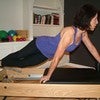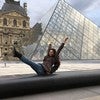Description
Because this is a high level exercise, Rael encourages you to wait until you are proficient in Pilates and have a very strong foundation before trying this exercise.
About This Video
Transcript
Read Full Transcript
Welcome to Bessie [inaudible] Academy, fully furnished with Bessie systems equipment which we are going to work on today. I'd like to thank Sherry senior faculty with Bessie PyLadies teachers all over the world and we've been together for 15 years. Sherry has been a committed and devoted student and I stress that point because what we're going to focus on today is the twist. Now I have to admit that I see the twist being done in ways that scare me. It scares me. The twist is an advanced, very advanced exercise, so we are going to show the full exercise. Sherry's going to demonstrate, I will cure through the exercise if I see things to correct, I will and then we are going to show you a few steps how to get to the beautiful work that Sherry does, but it is commitment. It is commitment.
This is the black belt of PyLadies. It's not something you delve into because you saw it somewhere on social media. That is how we, we need to protect this profession of ours. The way we protect it is that you need reverence and respect for the highest level of the work, all levels. But as you get higher, it shows that you have put in the years of work. Uh, I've got Sherry on one full spring and one light spring. It's to add that little bit of assistance. Um, the heavier people may need. Um, I doubt you need two springs, one spring plus a little assistance. So Sherry, one hand goes down two hands.
Try get that foot up there in a nice comfortable position. And these hands take the weight of the body as you vary in a controlled manner. Take the body up, placing the other leg around. So let's go. We put one hand, two hands and put this one, just a little here, Sherry, that'll help and feel that you pushing into the heel of the hand. That's where the support is. Put the other leg up.
It's nice and firm on that bar. And then very controlled. We lifting in and don't hook these toes around the ball. His toes are elongated. This leg just sits on top of that foot. So now she pushes the carriage out to about that point. From here it move as she swings the pelvis down like a swing, looks in that direction, swings the pelvis up and brings the kerogen.
So we take the carriage out, draw up the pelvis, keep the carriage still as you take the pelvis up and then bring it in and you go out and down and lifting,
And the exercise only ends at the point where you take the hands off. So it's a tough exercise. It's a tough exercise. So I'm going to just show it to you one time so that we have something to work on. Again, I've put my hand down, I put the other hand down, I put that foot there. I get a little bit of tension in the springs as I control it up. Look toward the back out. No movement, no movement, and then in out, no movements in the carriage, slowly down, bring the carriage in and that's where you come out of the position.
The person that told me about not moving the carriage as the calver swings down and up was my dear friend and mentor Kathy Grant. I did it for years, but I would ride the spring little bit like you doing. Kathy was very adamant when she saw me doing it. Rail go out halfway from then on, there is no movement in the carriage as you swing down and swing up and then bring it in and it's hard. It took me a while, a few years of hard work. First of all, to digest those words and then to practice it and get better and great work. Sherry, I'm so happy that we're gonna have years and years together still so.
So now we're going to move on to showing how we do it on the mat. That is where it all starts. The foundation, the roots of the exercise. Sherri, just note we're going to do the twist on the mat. Eh, this leg is the leg that takes the part of the work. You know, let's say the upper body takes 50% the call and then this leg here in the, in the, on the reforma, we actually put it in front here. We'll put this is the passive leg, the passive leg. This is the active leg on the match. It's a little easier to put it behind, but the back leg, this leg is passive. It goes along for the ride. I said 50% but rarely.
This is where all the action is. Let's say this is 50% 25% no 50% and a 30% and 20% the leg really doesn't do that much. I was never good at math. So, um, we ready. We inhale as we come into that beautiful line, that side plank. We make a statement in the site plan, glow with the pelvis just a little and pulling the Arabs a little.
Now go into your rotation. As she goes all the way through. Notice how the back extensors are working and she's in that beautiful pyramid shape, that up stretch position. She comes back to the side plank and I just want to make sure she's in alignment. Take the pelvis a little forward and then she slowly lowers the body down, barely touching. You can still get a piece of paper between her hip joint and the mat and reaching up, facing them, and then under as she reaches through and inhale pelvis a little forward.
Sherry and exhale as she comes down, notice this leg is going along for the ride. This is where your anchor is. Inhale, reaching up, reaching up, reaching up, and then she brings it through working with these rotators of the trunk. That's the twist. Inhale back and then slowly coming down into position, looking straight forward. So we don't look at the hand. Uh, do you have one more in you? Yes you do. And stabilizing with that scapula using the rotates as of the trunk. Gee Weaves that arm through. She comes back, pelvis forward. Use those abs, really pulling the ABS. They drop the pelvis, a little Sherry and then slowly lowers down to the mat.
So working on that gives you the strong foundation to then take it onto the reformer, starting on a low bar on the reformer middle bar, and then the one that cherry showed the most difficult, the high ball. Please prepare, prepare the body needs to be prepared for these high level exercises. Give it the reverence that it deserves. The hard work that it deserves. Beautiful work, Sherry. Thank you.
Comments

You need to be a subscriber to post a comment.
Please Log In or Create an Account to start your free trial.































